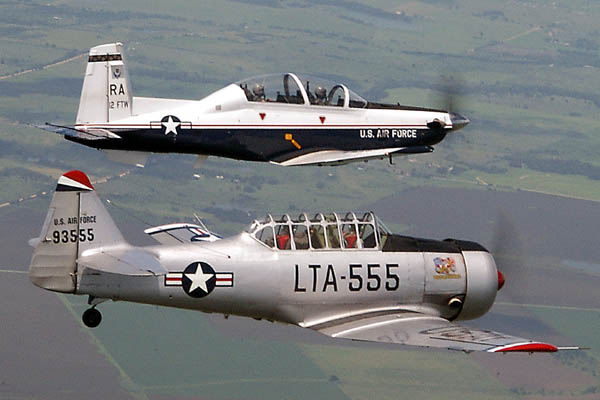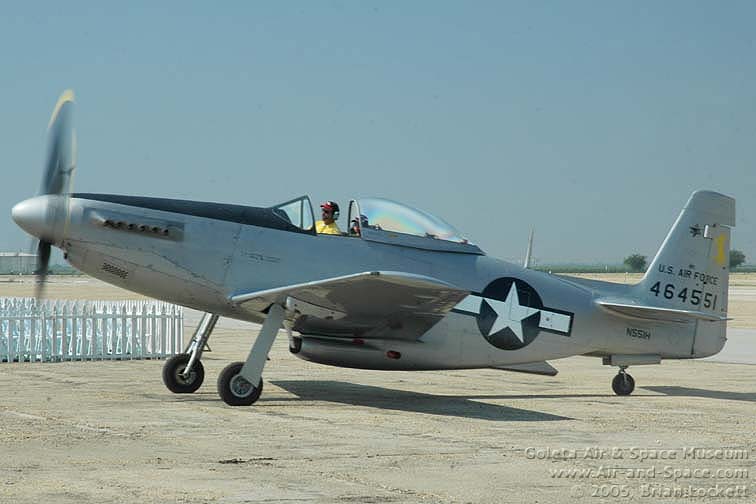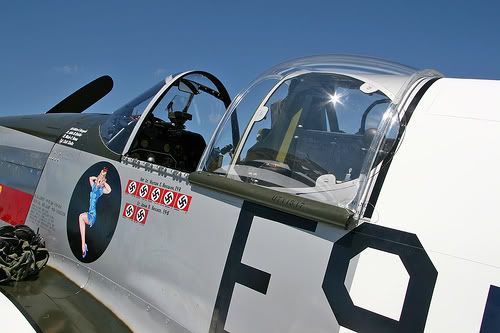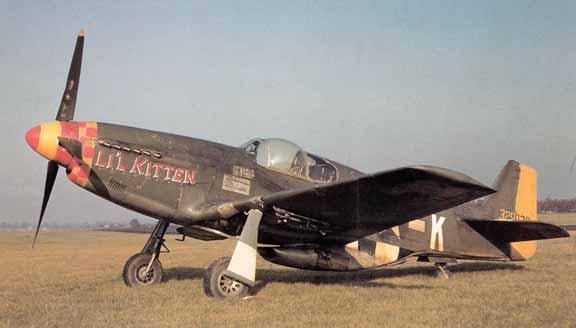
This rather sinister looking gent is Edgar Schmued, American with German heritage. Schmeud is an unsung hero in aviation because he designed one iconic aircraft after another.
Schmued was hired by James H. "Dutch" Kindelberger who was the Prseident of North American aviation as chief designer. Where Schmued impressed by designing a trainer aircraft that outperformed many of the fighters that the USAAF had in service: The BT-9 "Yale"

But the Yale as impressive as it performed was considered Obsolete very quickly as the threat of war pushed aircraft designs forward and planes had to become tougher and faster, the "Yale" was made according to WW1 specifications, steel tube fuselage spanned with fabric and wings largely made of wood.
Schmeud was asked to modernize the "Yale" which received an all metal construction, retractable landing gear and a more powerful engine, resulting in what was to become North American Aviation's first best seller: The T-6 Texan.
image removed
The Texan and it's Canadian built cousin the Noorduyn Harvard was a slamming success and many would be fighter pilot cut their teeth on flying this stable and forgiving plane. The Texan design was also adaptable for modification into close support aircraft, light bombers and fighters and A total of 15,495 T-6s of all variants were built in the USA, Canada (Noorduyn) and Australia (Commonwealth aircraft) Currently the Texan is being honored by having it's name revised on the Hawker Beechcraft T-6 Texan.

With war loomingthe British high command were coming to the sobering conclusion that they could not compete with Germany's industrial might and looking for fighter planes available on a larger scale than their own industry could produce. So in 1939 North American was asked to produce the Curtiss P-40 Warhawk for the British.

The legend began with Kindelberger asking, "Ed, do we want to build P-40s here?" Schmued had been long awaiting a question like this. His answer would begin the design process, "Well, Dutch, don't let us build an obsolete airplane, let's build a new one. We can design and build a better one." Schmued and his team went to work on a new design that would use the same engine as the warhawk but could be easier to produce and would outperform the P-40 on all fronts, to cut costs many of the hydraulics and the undercarriage of the T-6 Texan was used. The British set the deadline for the design to be ready at January 1941 but Schmued's master piece already flew in October 1940.
image removed
But what really made a difference with the Mustang was its wing. Up to then aircraft wings basically still used the design pioneered by the Wright brothers but Schmued and his team developed an entirely different design which allowed a higher speed with lower fuel rates.
The Royal Air Force ordered the plane as the Mustang Mark I and the USAAF placed an order for the production version of the P-51A and the dive bomber version the A-36 Apache.
(image removed)
The A-36 Apache, the ground attack version of the Mustang, it differed from the normal P-51A by having a thicker wing with bomb racks and dive breaks. Regardless, the A-36 wasn't that big a success and was quickly replaced by the P-47 in the ground attack role.

The Dive breaks of the A-36.
As 1940 turned into 1941 and with the Battle of Britain having rewritten the rules of aerial combat, the Royal Air Force started to receive the American planes it so desperately needed but when testing those planes against their indigenous fighters and captured German fighters found that they were far off the mark and it all was because of one common denominator: The Allison V-1710 Engine.

Now the Allison was a temperamental engine with a limited ceiling which required turbo super chargers with complex synchronization to really make it work. And for what the British needed their planes to do in the European theater, it was hopelessly inadequate for the job.
So the Curtiss P-40 Warhawks were send to Africa and Asia where they were used in the ground attack role, the Bell P-39 Airacobras were send to Russia and the Lockheed P-38 lightnings were send send back to the USA, since they simply couldn't find any use for them.
Also, when the lightning re-appeared in European skies later in the war, the plane had been suitably upgraded, even so, according to Luftwaffe ace Adolf Galland, the fame which the "Gabelschwanz teufel" (Devil with the double tails) received was highly overrated, since the Lightning wasn't very maneuverable, nor was it very fast.
But the Mustang soldiered on, and on both sides of the Atlantic people were looking for another powerplant, to turn this dependable workhorse into a thoroughbred. In both cases, they took a P-51A and replaced the Allison by a Rolls Royce Merlin, the same engine of the Spitfire. The results were such an improvement on fuel consumption and service ceiling that it was decided to take the merlin powered Mustang into production. A licencing deal was made with Packard Automobiles to start building Merlins in the states.

The P-51B and P-51C, which were identical to each other save from the factory where they were built, put the Merlin powered Mustang in production.

A P-51B and the earlier Allison powered P-51A next to each other, visually you can tell them apart by the bigger nose and the four bladed propeller of the B-model.
The next improvement of the Mustang was when they changed the canopy in favor of a sliding bubble, which gave the pilot perfect all view. Creating the P-51D which in every other aspect was identical to the B model.
image removed
For the first time there was a plane that could escort Bombers into Germany and Back again, in a very significant way, fitting a Merlin to the Mustang won the allies the war in Europe.
During the war the Mustang got several more updates, such as the P-51H model which was a complete redesign of the mustang, which shared no interchanging parts with the earlier marks.

But the H model never went into full scale production since the D model worked far better and the war was getting to a close.
Another derivative of the Mustang which DID enter full production was the P-82 (later F-82) Twin Mustang which was meant to replace the Lockheed P-38 Lightning.

A P-82 and a P-51D flying next to each other, showing the differences between the two types. The twin Mustang actually wasn't just two P-51 fuselages bolted together: the tail had to be redesigned and the actual wing span was less of two P-51's parked next to each other. The war ended however before the P-82 would see combat but the twin Mustang would find its niche in Korea where it flew as an all weather night fighter, scoring a respectable number of kills, in fact, it was a Twin Mustang that shot down the very first enemy plane.
But eventhough the P-51 found plenty of use after the war ended, with jet technology making piston powered fighters obsolete, it basically was the end for the Mustang.
Or was it?
Because North American's first jet fighter looked really familiar.
image removed
The FJ-1 Fury had the wings, tailplane, avionics and general outlay of the P51D. And the "Jet-Mustang" was developed further into the F-86 Sabre, which still had many interchanging parts with the Mustang.

The Fury and the Sabre flying next to each other.
And later when the US Navy issued a contract for a new trainer, the resulting T-2 Buckeye also had the old Mustang wing.
image removed
And in the late seventies the Mustang was given a new lease of life when Piper tried to market the Enforcer, which was a Mustang fitted with a Turboprop engine, meant as an alternative to the A-10 Warthog.
image removed
But they never went into full scale production and only two of which both are in this picture were built.










